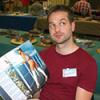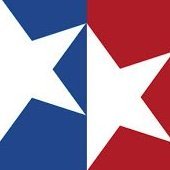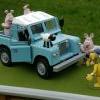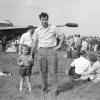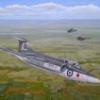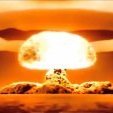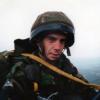Search the Community
Showing results for tags 'Thunderchief'.
-
Hello! This build from 2019 was inspired while reading the special issue of French magazine “Le Fana de l’Aviation” about the F-105 Thunderchief. A story in particular caught my attention. While on a bombing mission on the 23rd august of 1967, 1st Lt Dave Walrop shot down a first Mig-17 with his gun, before climbing to avoid debris and get back in formation. While coming back from the clouds flying on his back, Waldrop saw another Mig and shot it down too. When he was debriefing at the base, he got a phone call from… Robin Olds himself. From his F-4, this famous pilot was not happy to have seen a F-105 flying on the back and shooting down the mig he was engaging with his radar. This Mig could have been Olds’s fifth Mig Kill, making him twice an Ace. The Kit Trumpeter released this kit back in 2004. The model shows some shape issues as canopy section, nose curvature, mk117 bombs… Details are a bit basics for 1/32nd scale in the cockpit, wheel bays and exhausts. Many aftermarket were used: - Blackbox cockpit 32014 - Master pitot tube AM-32-038 - Quickboost air intake 32068 - Cutting Edge canopy and spine correction CEC32163 (OOP, hard to find) - Aires Wheel bay 2076 - Fisher Wheels A3219 - Eduard F-105 interior 32514 - Eduard F-105 Exterior 32113 - Eduard F-105 armament 32208 - GT Resin Fuselage correction set (nose, camera, ventral fin) - Videoaviation MK117 bombs 163932 Eduard MER 632102 Paints from Mr Hobby. Markings with home made masks and kit decals for stencils. Weathering with oils mostly I will add WIP pics in another post. Hope you like it! Romain
- 38 replies
-
- 83
-

-

-
Both BM and Google search yielded a several individual results of the two most prominent Wild Weasel 'Thuds' in 1/72 scale, but I couldn't get a good direct comparison between the two. Apparently the Monogram is an oldie but goodie and very accurate; its main point of criticism being the old-fashioned raised panel lines. The Trumpeter kit has more up-to-date engraved panel lines, and supposedly features a lot of detail. However, I have read about some accuracy issues, plus overdone and oversized riveting. Also, the decal colours are way off. Any Britmodellers out there who can give me some pointers? At this moment I tend to lean towards the Trumpeter kit because of the engraved panel lines, but if its accuracy issues are serious, I'd be willing to invest some time in the rescribing of a second-hand Monogram kit. Thanks in advance, Luka
-
The last operator of the Republic F-105G Thunderchief was the Georgia Air National Guard 128th TFS / 116th TFW based at Dobbins AFB in Marietta, GA. They took on the 'Wild Weasel' SAM killing mission that had originally started during the Vietnam War and kept the F-105G until the summer of 1983 when the venerable 'Thuds' were traded in for the F-4D Phantom. Several of the aircraft were painted in a wrap-around SEA camouflage scheme and I decided to take an old 1/48th Revell / Monogram F-105G kit out of the stash and finish it in this colour scheme, courtesy of a recently released Caracal Models decal sheet. It wasn't an easy build (more later) however the end result looks like this:- 20210620_133806 by Ghostbase, on Flickr The kit itself is excellent, way up there with the other Monogram 'Century Series' aircraft kits, and I was surprised with how well it went together. Very little filler was needed and in fact I was able to attach the complete wing sections to the fuselage after they had been painted. The Thunderchief was a huge aircraft and that really shows in this kit which measures 44cm x 22cm. 20210620_132826 by Ghostbase, on Flickr I used the weapons supplied with the kit, these being a pair of AGM-45 Shrike air-to-ground anti-radiation missiles that locked on and homed onto ground based tracking and fire-control radars, as well as a single AGM_78 Standard which is a passive anti-radiation missile with a range of 24 km. 20210620_132928 by Ghostbase, on Flickr The challenge lay in the painting of this huge kit. I used the Hataka Hobby USAF Paint Set (Vietnam War Era) #AS-09 and initially I started with applying the tan paint, it applied very well and the colour looked correct as well as the satin finish. However the two greens consistently clogged up my H&S Ultra airbrush and when they did spray the finish was splotchy and uneven. When I oversprayed a previously applied coat the paint would sort of atomise into its constituent parts! To cut a long story short I found that a replacement medium nozzle and needle on my airbrush worked wonders as did using a retarder as well as less thinner. The end result turned out ok anyway. 20210620_132556 by Ghostbase, on Flickr The decals come from the recent Caracal Models CD48143 F-105F/G "Wild Weasels" sheet which is well-researched and the decals are of a very high quality. As soon as I saw this sheet I knew I wanted to make this aircraft. 20210620_133106 by Ghostbase, on Flickr I am reasonably happy with the final result. It is a very large and impressive model and despite the painting heartache it looks good. Next time I might just add some wash to the major panel lines, also use a darker exhaust colour on the afterburner petals. Michael 20210620_132614 by Ghostbase, on Flickr 20210620_133219 by Ghostbase, on Flickr
-
With the F-105 foremost in my mind at present I thought I'd post a few images from a trip around Carswell in 1980. I'll post more once I have time to scan them. The first three are a flight heading out to the ranges in the early morning (around 08:00). The light was low and so the Kodachrome didn't perform well, hence the B&W. Note 61-0076 is named "Pandora's Play Thing". Martin
-
Here are the final photos of my conversion of a Monogram F-105D kit into the prototype YF-105A, and here is the Build Thread And for a little comparison, the original Monogram F-105D alongside: If you check out the build thread, you will see that it was a long ride... Ed
- 17 replies
-
- 37
-

-
The Thud over Germany – F-105s of USAFE 1961 to 1967 The Story Anyone who has stood in front of a Thunderchief can only wonder how young pilots could master such a massive beast with a huge engine and small wings, but during May 1961 the first F-105Ds were flown direct from the USA to Bitburg in Germany, where they replaced the F-100 Super Sabres of the 36th TFW. They were brand new aircraft. The 49th TFW at Spangdahlem also received its new aircraft from October 1961 onwards. This was at the height of the Cold War and their principal role was nuclear strike, a mission known as ‘Victor Alert’ in the USAF. This was a big, complex aeroplane and brought with it big, complex maintenance problems. So much so that all aircraft were upgraded from 1962 onwards to a nominally common standard in a programme named ‘Project Look Alike’. This included many system upgrades but also required improved sealing between panels and a painted aluminium finish. An airfield arrestor hook was also fitted. Centralised maintenance was also introduced which meant an end to individual squadron markings. By the mid 1960s the Vietnam war was taking a significant toll on F-105s and during 1966 and 1967 the F-105s were transferred back to the USA as attrition replacements. By then there were enough F-4D Phantoms for the USAFE wings to re-equip. The colour schemes Aircraft were delivered in natural metal finish with glossy black radomes and matt olive drab upper fuselage. Those returned from the ‘Look Alike’ upgrades had the aluminium paint finish which replaced the natural metal. Finally the Vietnam type camouflage was applied during 1965, which also removed all squadron markings. Squadron markings were applied as follows: 36th TFW had three squadrons which were the 22nd, 23rd and 53rd TFS. Initially, during the natural metal period, each squadron displayed it’s colour on the fin in the form of 3 coloured stripes on a white diagonal background. The colours were 22TFS red, 23TFS blue and 53TFS yellow. After centralised maintenance was introduced all three colours were carried on the white diagonal on the fin. The 49th TFW squadrons were the 7th, 8th and 9th TFS. (7TFS blue, 8TFS yellow, 9TFS red). All aircraft carried a fin flash consisting of the wing badge and the three squadron stripes. Individual squadron colours were carried on undercarriage doors and sometimes on the nosewheel leg radar reflector. After centralised maintenance a three-coloured lightning flash was carried on the nose in addition to the fin marking. When camouflage was introduced, no wing or squadron ident was carried. The Models F-105D 60-0466 36th TFW / 22nd TFS, Bitburg, 1961 illustrating the early natural metal scheme. This is the fairly rare 1/72 Revell kit (looking very much like a down sized Monogram 1/48 kit). The kit represents a late Vietnam war F-105D and needed back dating. This meant removal of RHAW antennas, strike camera, wing strengthening plates, engine cooling scoops and gun cooling vents. The fin leading edge cooling intake needed enlarging and the aft part of the spine in front of this intake needed removing. Since the kit has raised line surface detail, this was all removed and re-scribed. This was all quite a lot of work but this is the best shaped F-105D so it was worth it. Finish was Alclad and AK metallics over Tamiya primer. Decals were mainly from Wolfpack. F-105F 63-8300 49th TFW / 9th TFS, Spangdahlem, 1963 illustrating the aluminium painted finish. This the Airfix kit with replacement canopy. The nose shape is too bulbous on this kit but it was the only 2 seater I had at the time! The Revell F-105G would make a better basis for this if you can face all the back dating and re-scribing! This also illustrates the red squadron colour on the undercarriage doors. F-105D 60-0511 49th TFW, Spangdahlem, 1965 illustrating the Vietnam camo finish. This is from the old Hasegawa kit. This was used as it represents the right configuration – i.e. it doesn’t have RHAW antennas, cooling scoops and vents, etc. The nose and canopy are not quite right on this kit and the undercarriage legs are about 1 cm too long – if you built it from the box you will have a Thunderchief standing on tip toes. The wing pylons have been replaced (kit pylons are far too small) and the drop tank fins were ridiculously thick and have been reworked. If I wanted another F-105D I wouldn’t go for this one! Maybe the Trumpeter kit would be better if you don’t mind all those rivets.
-
'Afternoon all, Following my very poor coverage of Mr Toad - who is poised on the shelf awaiting a varnish coat and then RFI - I am going to attempt to keep up with posting on the next Kartveli machine. This time I am giving myself a little more construction work, given that I am attempting to marry a Hasegawa F-105B nose to a Trumper F-105D. I've already noticed that the Trumper is a little shallow in the nose area (only slightly) and so matching it to a slightly (very) overblown nose on the Hasegawa. Other than this the construction will be pretty much like my last two Thuds, with the removal of the strengthening plates, fin tip antennas, ventral fin, dorsal wiring duct, etc. The bit I am fearing the most is re-scribing her after the new nose is on..... assuming I get that far!! I wont be posting anything that repeats previous Thud builds as I think that is a bit tiresome. I will concentrate my postings on the nasal challenge. Right now I am getting the basics together, with the cockpit installed and a few of the simple add-ons. Helping me along will be some PE and resin. I'd appreciate your inputs as and when it seems appropriate to keep me on the straight and narrow The machine I intend to depict is 54-0107, an F-105B used by Republic as part of the "Phase 5" testing. She is illustrated here and there on the net. Hopefully I will get to this: Here she is during her career: Martin
- 66 replies
-
- 13
-

-
- Thunderchief
- F-105
-
(and 1 more)
Tagged with:
-
Hi all, I have finally summoned the courage to embark on the first of what I hope will be three Thud builds over the coming weeks. I'll send out my previous caveat that it will take a while as I have to fit it around many other things and time is short generally. None of that will dampen my enthusiasm, although I am impatient by nature and you may need to hold me back if I am rushing for the sake of finishing. The goal is a representative build and not a half-way copy. Many of you will have seen and been a part of my recent deliberations on WIP about this first machine, which is different to say the very least. As always she is being built in the Gentleman's scale - 1/72. Is there really anything else? I grew up with 1/72 and will stick with it. The follow on builds will be F-105D 59-1749 "Mr Toad/Marilee E" and then F-105B 54-0107 in her Phase 5 colours. So, 58-1155 looked like this: She was a test airframe that went on to operate with the USAF and then the Air National Guard and now resides in USAF Armaments Museum at Eglin AFB, marked erroneously as 59-1771/JV "Ohio Express". The debate on WIP has mainly been about the fin/rudder and nose "balloon" colour. A poor (in my view) image that is available shows this to be a pale yellow, like something you'd get from Dulux for your bathroom in the 1970s. It isn't my cup of tea but, of course, if that is what it was then it will be painted that way. My challenge is to prove this to myself. Other than that she was natural metal, International Red flashes outlined in black, (silver)-outlined lettering and Star-and-Bar, Olive/Green spine and a black anti-flash panel behind and in front of the canopy. You can see that she had a longer pitot with some test vanes and a ventral fins without arrestor hook. She also pre-dated the wire duct along the spine and the rear fuselage scoops normally seen on later Thuds. I have a couple more rewfernce shots but if anyone out there has more I'd love to see them, especially anything that confirms (or otherwise) those yellow areas ;). So far I am in the "gathering" stage - getting my bits together and starting to make a work plan. This is what I have so far: This includes an Aires cockpit for each, pitot (for Mr Toad), wheels, canopy masks, and more. Well wish me luck! I need it!!!!!! Martin
- 214 replies
-
- 8
-

-
- trumpeter
- thunderchief
-
(and 1 more)
Tagged with:
-
Hi all, Having recently treated myself to the truly excellent tome of Thud units histories by James Geer, I have finally taken the plunge and purchased a kit (a Trump) and a fair bit of resin. My plan is to build "Mr Toad"/"Marilee E" 59-1749. It is a reverse pattern machine from the Vietnam era.m My question? Does any Thud expert out the have an images showing the "Mr Toad" motif? Thanks in advance, Martin
- 12 replies
-
- 59-1749
- thunderchief
-
(and 1 more)
Tagged with:
-
Sorry but I lied.... just three more. These are others I've taken shots of Stateside. All were taken in May 1979, the two preserved machines being at Lackland AFB and the cockpit being amongst the Thud bits at Davis Monthan AFB.54-0107 was a straight B model (the third Thud built) and used for testing. 54-0105 is a JF-105B, a projected recce version that failed One of only two built. She was used for testing also. Sadly when I saw her she was in this ficticious scheme whereas in reality se had a glorious natural metal/red scheme, coded "JF-1". The cockpit is of 60-0438, once a Bitburg machine. It is shown in the RIT (reclamation) area. Martin
-
Here is my tribute to the Thud. I chose to do the landing gear up as I have read that the kit landing gear is very rickety and besides, I never seem to have luck with landing gears. I battled with silvering decals but that was my own fault for not spraying a gloss coat on first. Colours used were all Humbrol, censoring done using MS Paint. I chose the I scratchbuilt the centreline bomb rack as I did not want to use the Bullpup missiles supplied by the kit as it is not very 'Nam and because I like to make my life difficult. I'm not too sure if this weapons configuration was actually used with all of the Mk 82s but I don't have anything else to put on and I think it looks pretty cool Tried the salt technique to give some weathering effects
-
Its 1965 and the USA is deeply engaged in the war in Vietnam. The F105D Thunderchief is one of its main strike aircraft, but the NVA is fighting back hard and the F105D is taking heavy casualties As well as the tenacious Mig pilots, the US Air was was dogged by the Soviet designed SA 2 'Guideline' Surface to Air Missile (SAM). This missile was supplied to North Vietnamese by the Soviets - the Vietnam War was the first modern war in which guided antiaircraft missiles seriously challenged highly advanced supersonic jet aircraft. It would also be the first and only time that the latest and most modern air defense technologies of the Soviet Union and the most modern jet fighter planes and bombers of the United States confronted each other in combat. Indeed, nearly 17,000 Soviet missile technicians, and operator/instructors would deploy to North Vietnam in 1965 to help defend Hanoi against American bombers, while North Vietnamese missilemen completed their six to nine months of SAM training in the Soviet Union. From 1965 through all of 1966, nearly all of the 48 U.S. jet aircraft shot down by SAMs over North Vietnam were downed by Soviet missile men. The Soviet Union supplied 7,658 SAMs to North Vietnam, and their defense forces conducted about 5,800 launches, usually in multiples of three. By the war's end, about 205 aircraft had been lost to North Vietnamese surface-to-air missiles. The USAF decided to counter the problem - initially with the 2 seat F105F Thunderchief 'Wild Weasel III' after a version of the F4C Phantom failed. The aircraft were armed with 2 x AGM45 Shrike ARMs and 1 x AGM78 Standard ARM for longer ranges. Eventually the USAF converted 61 F105F's to G standard. Meanwhile the RAF was going through its normal painful procurement process, whilst keeping an eye on the USAF and the ongoing war in Vietnam. Whilst eventually ordering the Harrier GR1, Phantom FGR2, Jaguar GR1, Buccaneer S2B and later the Tornado GR1, it became apparent that the Wild Weasel mission would be vital in any war against a Soviet backed foe. The RAF requested an order of 20 x F105G in late 1974, just before the Vietnam war was coming to its bitter end in 1976. However production had ceased - an agreement was made between the MoD and the Pentagon, where the RAF would send 20 crews to the USA to be converted to the F105G and trained by combat experienced pilots. As part of this agreement, the RAF would 'Lend/Lease' 16 F104G Thunderchiefs to equip 1 frontline RAF Squadron. 41 Sqn had been earmarked to move to RAF Coltishall and convert to the new Sepecat Jaguar. The decision was taken to assign 41 Sqn to the Thunderchief and the new challenge of the Wild Weasel role, based out of RAF Wattisham in Suffolk. The logic was that the aircraft should not be committed to RAF Germany, but rather held in UK ready to deploy as required. The Squadron utilised the overhauled ex USAF airframes, keeping most of the USAF equipment needed to fly them (much as the F4J UK purchase), however they were painted in the current RAF colours of DSG/DG over LAG. They operated in a similar fashion to the USAF, often working with other RAF strike aircraft; the Thuds were kept in service to cover this capability gap until 1986. But by then the airframes were worn out. The RAF lost the Wild Weasel capability, in 1990 the ALARM ARM was finally bought into service and equipped Tornado Sqns - however the RAF was never again to have a true Wild Weasel capability. For this Group Build I will build a 1/72 Trumpeter F105G Thunderchief (on its way via Evil Bay at a reasonable price), with some decals grabbed from various 1/72 RAF builds. Stencils will mostly reflect the USAF airframe. Stolen Decals that have 41 Sqn markings:
- 64 replies
-
- 6
-

-
Hello peeps of BM. Here's my 1/48 Revell Monogram F-105F Thunderchief, done as a pre-Vietnam War jet, with the 8th TFS, 49th TFW based at Spangdahlem AFB in Germany. This is the fourth Spangdahlem based model I've done so far, and the first one from the 49th TFW. Painted with Alclad flat aluminium, decals from Fowler Aviation and some Superscale. Seats from True Details. Fueltanks will be added later on. Thanks for watching and I hope you like it.
-
F-105D Pics by Darwin taken at the Combat air museum in Kansas

